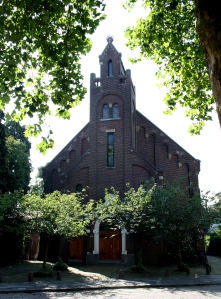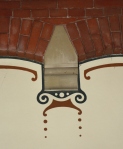Tags
Architecture, Art Nouveau, Chandelier, Church, Decoration, Design, Dordrecht, Jugendstil, Lamp, Open Monumenten Dagen 2012, Painting, Reus, Wall Decoration
 On 27 August 2012 I wrote about my excitement over the upcoming Open Monument Days event. One of the buildings I really wanted to visit was the Remonstrant Church (Remonstrantse Kerk) at Cornelis de Wittstraat 28.
On 27 August 2012 I wrote about my excitement over the upcoming Open Monument Days event. One of the buildings I really wanted to visit was the Remonstrant Church (Remonstrantse Kerk) at Cornelis de Wittstraat 28.
From the outside, the church never appeared very spectacular to me, but I had read in the event booklet that the inside was supposed to be something else!
In 1897 a large group of people decided to leave the Protestant Church and form their own association, the ‘Remonstrantse Vereeniging’.  After only 10 months, the parish was officially recognised by the General Assembly of the Remonstrant Brotherhood which paved the way for buying land, owning possessions – in short: becoming a legal entity.
After only 10 months, the parish was officially recognised by the General Assembly of the Remonstrant Brotherhood which paved the way for buying land, owning possessions – in short: becoming a legal entity.
In 1900 the parish got the opportunity to buy a piece of land from a widow, and paid fl 11,50 per square meter (approx. €5,-). Next, they organised a competition to design a church, in line with a whole list of requirements. The committee asked 2 architects from Dordrecht, H.A. Reus and H.W. Veth, to submit a design. Later, another Dordrecht architect, C. van den Hoogenband, spontaneously submitted a design for the competition.
 Reus’ design with the motto “Unity in the Necessary, Freedom in the Uncertain and in Everything Love”, turned out to be the winning design, and in July 1900 the construction of the church actually started. Only 8 months later, the church was finished, and superintendent Nooteboom got a fl 100,- (approx €45,-) bonus for having finished the project in time. The whole church cost no more than fl 25.000,- (approx €11.000,-).
Reus’ design with the motto “Unity in the Necessary, Freedom in the Uncertain and in Everything Love”, turned out to be the winning design, and in July 1900 the construction of the church actually started. Only 8 months later, the church was finished, and superintendent Nooteboom got a fl 100,- (approx €45,-) bonus for having finished the project in time. The whole church cost no more than fl 25.000,- (approx €11.000,-).
The outside of the church was designed in a Rationalistic style, the style of architect Berlage whom Reus had worked with and admired very much. The interior of the church though, was designed in the more decorative Art Nouveau style. Reus even designed chandeliers with whiplashes and curved wooden benches.
In 1909, the vicar suggested to have the wall behind the pulpit decorated, as the plain wall had turned out to be a bit boring. Reus was asked for advice and he made a first design. Due to indecisiveness, nothing got decorated until Reus made another design in 1911. Kromhout, a decorator from Amsterdam, was commissioned to decorate the walls for fl 390,- (€180,-) which he did just marvelously. And having been there, I can confirm that the interior of the church – after 100 years – is still magnificent!
There isn’t much more to add to the story as the pictures speak for themselves. Please enjoy these examples of exquisite Art Nouveau design by H.A. Reus.
Update September 2014: The sexton told me she had received a call from the Katwijks Museum last year when they were preparing an exhibition about Willy Sluiter and found evidence that Sluiter designed the limestone doves at the entrance of the church.
De Remonstrantse Kerk, C. de Wittstraat 28, 3311 GD Dordrecht
















Pingback: H.A. Reus (1872-1935) « Art Nouveau
Pingback: Why there is so little Art Nouveau in The Netherlands « Art Nouveau
Pingback: Preparations for the Open Monuments Event 2013 | Art Nouveau
Pingback: Preparations for the Open Monuments Event 2014 | Art Nouveau
Pingback: Preparations for the Open Monuments Event 2016 | Art Nouveau
Pingback: Preparations for the Open Monuments Event 2015 | Art Nouveau
Pingback: Preparations for the Open Monuments Event 2017 | Art Nouveau